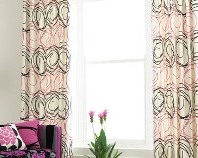Exotic Hotel Therapy Is Good for the Designer's Soul
 November 22, 2011
November 22, 2011 (Hotel Amiris, Marrakesh, Morocco)
 Janet Ramin - One of my main thrills in traveling abroad is the hotel experience. Sure, tasting new cuisines and meeting the natives is always exciting but I look forward to kicking off my dusty shoes and just relaxing at my lodgings too. First, there’s the small but important detail – the room is already clean and neat – you don’t have to deal with personal messes. Then there are the amenities that you may not have in your own home – the powerful jet spray in the shower or the spa toiletries on that dual sink marble vanity. And of course, there’s that menu near your phone – cocktails and midnight snacks ready to be ordered in a moment’s notice.
Janet Ramin - One of my main thrills in traveling abroad is the hotel experience. Sure, tasting new cuisines and meeting the natives is always exciting but I look forward to kicking off my dusty shoes and just relaxing at my lodgings too. First, there’s the small but important detail – the room is already clean and neat – you don’t have to deal with personal messes. Then there are the amenities that you may not have in your own home – the powerful jet spray in the shower or the spa toiletries on that dual sink marble vanity. And of course, there’s that menu near your phone – cocktails and midnight snacks ready to be ordered in a moment’s notice.
Besides service amenities, you have the lifestyle aspect. You may live in a cramped city apartment but for a few days or so, you can experience life in a lakeside rustic cabin or a petite villa by the sea. Then there are the grand old palaces that some enterprising soul converted into hotel rooms – borrowed luxury to be remembered for a lifetime. I personally look forward to checking out the hotel designs, especially those in foreign countries.
 (Courtyard, Riad Amiris, Marrakesh)My first stop on my trip was behind the walled medina of Marrakesh. I opted to stay at a traditional riad, instead of a regular hotel. Riads are converted courtyard palaces – the word “ryad” comes from the Arabic word for garden. These traditional Arabic homes featured small windows on its exterior – to keep the hot sun out – and inner courtyards to maintain Islamic beliefs of privacy.
(Courtyard, Riad Amiris, Marrakesh)My first stop on my trip was behind the walled medina of Marrakesh. I opted to stay at a traditional riad, instead of a regular hotel. Riads are converted courtyard palaces – the word “ryad” comes from the Arabic word for garden. These traditional Arabic homes featured small windows on its exterior – to keep the hot sun out – and inner courtyards to maintain Islamic beliefs of privacy.
Above are two photos of the Riad Amiris in Marrakesh. The courtyard has an opening above – with a retractable canopy - to let the light in but still allow for privacy for its guests. The walls and doorways are decorated with traditional Moorish carvings of intricate geometric designs. The low tables are also set with the traditional tea glasses and silver, ready to serve mint or verveine tea - a verbena-infused tea.
(Room of Hearts, Riad Amiris)Above is one of the guestrooms at Riad Amiris called Chambre des Coeurs, or Room of Hearts. The bed and floor is covered with typical Arabic woven rugs. The color scheme of the room shows off a bright cobalt blue, a popular Moroccan color. A brass screen with Arabic pointed arches and scrolls provide the accent touch.
After Marrakesh, I traveled to the south of Spain, visiting Seville and Malaga. Seville is an old city with Moorish roots so many of its architectural features reflect Moroccan designs as well. The hotel that I stayed in was the Petit Palace Marques Santa Ana. Similar to the riad I stayed at in Marrakesh, the Marques Santa Ana also featured a central courtyard from which the guestrooms radiated. But the similarities ended there. The hotel used to be a nineteenth century Seville mansion and featured more classical - as in Italianate - columns and rounded arches – as seen in the lobby of the photo. The guest rooms have been completely modernized, featuring platform beds and abstract artwork.
 (exterior, courtesy of Petit Palace Marques Santa Ana, Seville)
(exterior, courtesy of Petit Palace Marques Santa Ana, Seville) (lobby and gallery, courtesy of Petit Palace Marques Santa Ana, Seville)After Seville, I flew into the capital, Madrid, where I stayed at La Posada del Leon de Oro or the Inn of the Golden Lion. La Posada was located in the city's old quarters, La Latina, and built on top of underground caves, hence the street's name, Calle Cava Baja. You can still see part of the cave - under the hotel restaurant's glass floor - where they also store the wine (see photo below). The inn also houses an enotaberna or tavern that serves mouth-watering tapas and Spanish wine along with a full-service restaurant.
(lobby and gallery, courtesy of Petit Palace Marques Santa Ana, Seville)After Seville, I flew into the capital, Madrid, where I stayed at La Posada del Leon de Oro or the Inn of the Golden Lion. La Posada was located in the city's old quarters, La Latina, and built on top of underground caves, hence the street's name, Calle Cava Baja. You can still see part of the cave - under the hotel restaurant's glass floor - where they also store the wine (see photo below). The inn also houses an enotaberna or tavern that serves mouth-watering tapas and Spanish wine along with a full-service restaurant.
 (restaurant, courtesy of Posade del Leon de Oro)The owners recently renovated the inn - reopening in 2010. In the guestrooms of La Posada del Leon de Oro, designers combined rustic charm of the rough-hewn wood beams with modern touches, such as the graphic art headboard - showing a silhouette of a Madrid cathedral - and the multi-plane acrylic hanging light.
(restaurant, courtesy of Posade del Leon de Oro)The owners recently renovated the inn - reopening in 2010. In the guestrooms of La Posada del Leon de Oro, designers combined rustic charm of the rough-hewn wood beams with modern touches, such as the graphic art headboard - showing a silhouette of a Madrid cathedral - and the multi-plane acrylic hanging light.
 (Posada del Leon de Oro guestroom)Design plays an important part, in addition to the amenities, in giving a weary traveler much needed therapy – even if it’s just visual therapy. The design can set the mood and introduce you to the local cultures of the country you’re visiting - a good beginning to any journey.
(Posada del Leon de Oro guestroom)Design plays an important part, in addition to the amenities, in giving a weary traveler much needed therapy – even if it’s just visual therapy. The design can set the mood and introduce you to the local cultures of the country you’re visiting - a good beginning to any journey.
 This article was reprinted by permission of the Sheffield School, New York, NY. Sheffield began as an Interior Design school in 1985, and then expanded our course offerings to train people in other design-related fields, including Feng Shui, Wedding and Event Planning, and Jewelry Design. With thousands of active students and more than 50,000 graduates, Sheffield has trained more design professionals than any school in the world.
This article was reprinted by permission of the Sheffield School, New York, NY. Sheffield began as an Interior Design school in 1985, and then expanded our course offerings to train people in other design-related fields, including Feng Shui, Wedding and Event Planning, and Jewelry Design. With thousands of active students and more than 50,000 graduates, Sheffield has trained more design professionals than any school in the world.
- Request a free Sheffield School catalog describing our distance education courses.
- Subscribe to the Sheffield Designer newsletter.
![]() Click here to subscribe to our daily design videos and features.
Click here to subscribe to our daily design videos and features.
 Morocco,
Morocco,  Spain,
Spain,  architecture,
architecture,  hotel,
hotel,  travel in
travel in  architecture,
architecture,  color
color 












Reader Comments